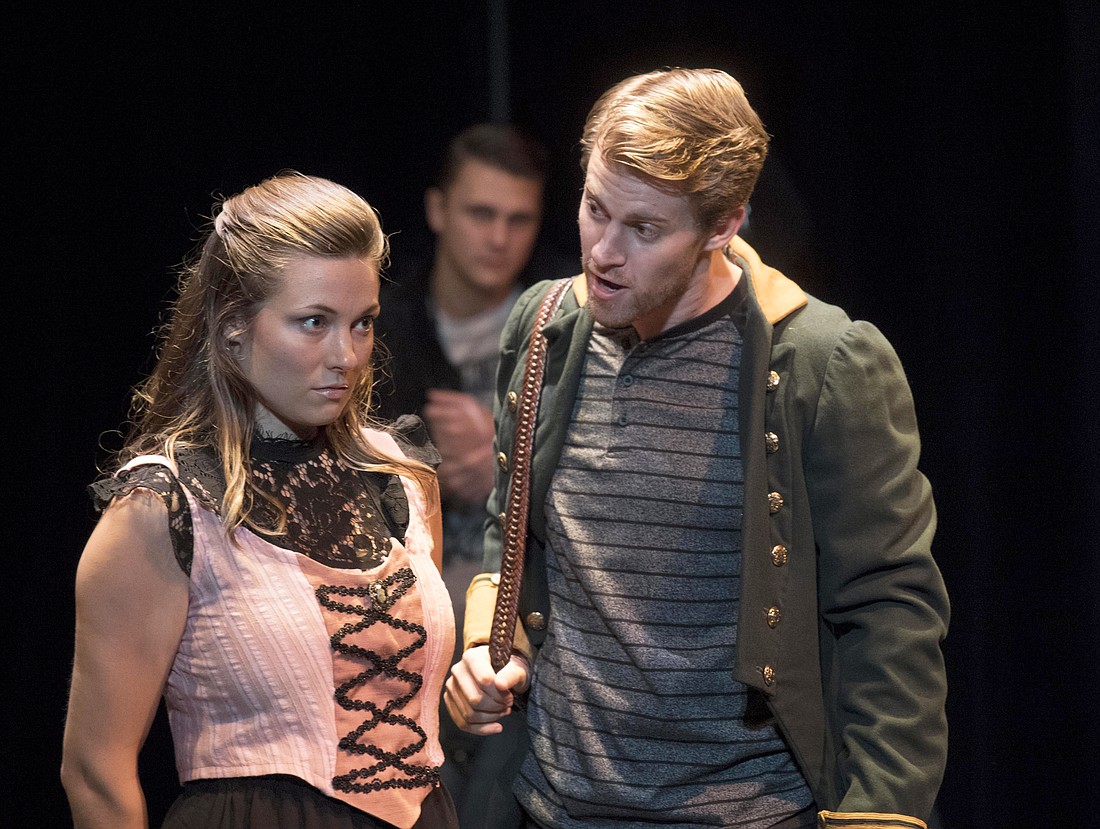- July 4, 2025
-
-
Loading

Loading

Shakespeare’s original “Hamlet” had a play-within-a-play. “The Tragedy of Hamlet” is more like a play-standing-to-the-side-of-the-play. A miniature companion piece that illuminates the original but never pretends to be a replacement. The playlet in question recently hit the stage at the FSU Center for the Performing Arts. Here’s my take.
It all revolves around a clever conceit. In his dying words, Hamlet charged his friend Horatio to “tell my story.” Supposedly, Horatio wrote this play to do just that—and is taking the production on tour. Director Justin Lucero actually created the adaptation/condensation. It’s now touring for real in a New Stage production with a rotating cast of third-year acting students from the FSU/Asolo Conservatory. It’s Shakespeare on the road, with education in mind. Over the next two months, they’ll tell Hamlet’s story at schools and performing arts venues across the state of Florida.
So, pretending to be Horatio’s troupe, these young actors deliver great, quick-change performances. Some had just a few lines, so I’ll stick with highlights.
Scott Kuiper’s Hamlet is more of an angry young man than a sulking Goth. He has no trouble making up his mind—he’s just waiting for the right moment to strike. Jessie Taylor’s Ophelia isn’t the standard willowy waif. She’s levelheaded and not that fragile—until tragedy robs her sanity. Brett Mack’s Claudius reminds me of the smarmy boss in “Office Space.” (I imagine him telling Laertes, “If you could poison Hamlet in the sword fight, that’d be great.”) Jacob Sherburne’s Polonius is a pompous pontificator. It’s a funny performance—although the blowhard turns terse in Lucero’s condensed version.
Now, let’s talk about the cuts. To put them in context, Kenneth Branagh’s 1996 film adaptation of “Hamlet” retained all the words—and clocked in at just over four hours. Most film and stage productions do a little trimming. Lucero’s adaptation cuts to the bone—and unfolds in 45 minutes. If brevity is the soul of wit, this is a very witty play.
Stripped of words, the play’s bloody deeds and bloody-mindedness jump out at you. The resulting on-stage experience is entertaining—part fever dream, party crime report.
To achieve this distillation, Lucero cut out many side trips, subplots, and good lines (does Shakespeare have any bad lines?) and fuses Rosencrantz and Guildenstern into the single person of “Rosenstern” (who seems to survive). Yorick’s skull goes missing, along with a few obscure Elizabethan expressions. (“Fardels bear” becomes “burdens bear.”) In his boldest revision, Lucero divides up Hamlet’s “To be or not to be” speech among all the main actors.
Purists may cry havoc, but I’m OK with it. Hamlet’s train of thought anticipates existentialism. Every decision is really a life or death—from getting out of bed to going into battle. Life is a choice. (Alternatives include suicide—or living on false terms.) “To be or not to be” really is the question. Hamlet isn’t the only one to face it.
Chopping up Hamlet’s soliloquy illuminates the philosophy behind it. Not coincidentally, it also serves up a meal of meditation in bite-sized pieces. High school students with systematically shortened attention spans won’t choke.
That’s no insult to “kids these days” or the play’s intent. Like running, mental focus improves with exercise. You start with sprints, then build up to marathons.
This adaptation is a doorway into Shakespeare, not a substitute. The structure it reveals is interesting in its own right. Cutting “Hamlet” to the bone reveals the play’s skeleton. A fascinating X-Ray, to be sure. But it makes you hunger for the too, too solid flesh.
That, of course, is the whole idea.